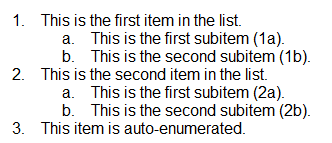Ordered (numbered) enumeration list
An ordered (numbered) enumeration list consists of text blocks (bullets) starting with a number or a letter and a separator followed by a space. The list items follow a certain sequence.
Properties
- The list items are left aligned.
- The enumerator indentation determines whether the item is a main list or a sublist. The enumerator of a sublist starts at the level of the text of the list items in the main list.
- There is a space between the separator and the text.
- If the text of a list item extends over several lines, the text of the continuation lines must begin at the level of the text of the first line.
- A blank line must be inserted before the first list item on a level. Blank lines between the individual list items and after the last list item on a level are optional.
- In the Library Manager, the main list and sublist are displayed as one block without blank lines.
- The following enumerators are recognized:
- Arabic numerals: 1, 2, 3, ... (no upper limit)
- Capital letters: A, B, C,..., Z
- Lower-case letters: a, b, c,..., z
- In addition, the auto-enumerator "#" can be used as a enumerator to automatically number a list. Automatically numbered lists can start with an explicit enumeration (Arabic numeral) that determines the sequence. Fully automatically numbered lists use Arabic numerals and start with 1.
- The following separators are recognized, but a dot is always displayed in the Library Manager:
- appended with a dot: "1.", "A.", "a."
- enclosed in brackets: "(1)","(A)","(a)"
- followed by a right parenthesis: "1)", "A)", "a)"
- A new list is always started when
- an enumerator is found that does not have the same format and sequence type as the current list (e.g. "1." "(a)" creates two separate lists);
- the enumerations are not in the sequence (e.g. "1." and "3." create two separate lists).
- The second line of each enumeration is checked for validity. This is to prevent ordinary paragraphs from being misinterpreted as list items when they start with text that is identical to enumerators. This text is parsed as an ordinary paragraph, for example:
A. Einstein was a really
smart dude- However, ambiguity cannot be avoided if the paragraph consists of only one line. This text is parsed as an enumeration in a list:
A. Einstein was a really smart dude- If a single-line paragraph starts with a text identical to an enumerator ("A.", "1."), "(b)", etc.), the first character must be preceded by a backslash so that the line can be interpreted as a normal paragraph:
\A. Einstein was a really smart dudePrinciple
+-----+-----------------+
|"1. "|list item |
| |(body elements) |
+-----+-----------------|
Sample
The following sample shows an ordered (numbered) enumeration list with two levels. There are three spaces before the list items in the sublist.
(In sample project: B_DocuElements\Lists\FB_Libdoc_OrderedNumberedEnumerationList)
(*
1) This is the first item in the list.
(a) This is the first subitem (1a).
(b) This is the second subitem (1b).
2) This is the second item in the list.
(a) This is the first subitem (2a).
(b) This is the second subitem (2b).
#) This item is auto-enumerated.
*)
|
